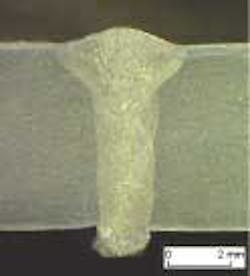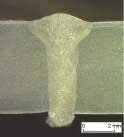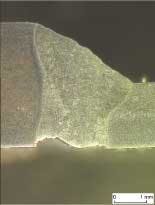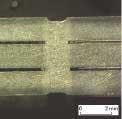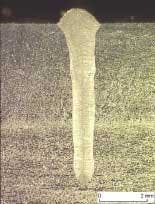Industrializing fiber lasers
Recently a new type of laser entered the multi-kilowatt range for laser materials processing. In less than two years, high-power fiber laser developers have scaled laser power from a few hundred watts up to 10 kW and more. Now as these lasers enter the industrial market they have to demonstrate their applicability in manufacturing applications. At the Bremer Institute für Angewandte Strahltechnik (BIAS—Bremen, Germany), welding studies were performed on steel and aluminum using a 7kW fiber laser from IPG Photonics (Oxford, MA).
This laser offers many advantages compared to conventional lamp- or diode-pumped rod type lasers. In addition to a high efficiency, the fiber lasers have a compact design, good beam quality, and a robust set-up for mobile applications. Laser power scaling is accomplished by a modular design. The thin working fibers can be used with a resulting small focus and high brightness because of the improved beam quality. The guaranteed lifetime of the pumping diodes exceeds the expected lifetime of other diode-pumped lasers, which leads to low costs of ownership.
Because there is a power limit for commercially available, conventional rod lasers, there are only a few known welding studies at higher power levels. These were carried out with special beam sources or by combining the beams of two or more sources into a high-power delivery system. In both cases the beam quality was poor. Now there is a laser source—the fiber laser—that combines both high power and high beam quality in a modular design. This high power can be utilized either for deep penetration welding of thick sheet metal or in thin sheets, a process up until now restricted to high-power CO2 lasers.
Aluminum sheets and profiles of up to 6mm thickness are used in large structures, especially for railway and aircraft welding applications. The complexity of the beam guiding and machinery for CO2 lasers to weld these structures is very high. In the automotive industry Nd:YAG lasers up to 4 kW power have been the preferable choice. With higher laser power, the welding speed, and thus the productivity, could be increased significantly, however the dynamics of the robots could limit the performance.
Excellent welds on aluminum in butt and overlap joints were achieved using the 7kW fiber laser at BIAS. Using a 0.5mm spot diameter the processes were stable with a remarkably small number of defects, such as blowholes. Figure 1 shows a butt weld in 6mm AA6056 aluminum at a welding speed of 3 m/min. The welds show slim fusion zone geometry with a high depth-to-width ratio. Also, simulated aluminum tailored blanks were welded with reasonable quality (see Figure 2).
Figure 3 shows an overlap weld of three 1.5mm zinc-coated DC04 steel sheets with a total thickness of 4.5 mm. The welds show a pore-free cross section with sufficient fusion area. The new fiber lasers may find applications for processing thick sheet metals such as in the offshore or pipe industries, which today are typical applications for high-power CO2 lasers. Figure 4 shows a bead-on-plate weld in stainless steel with a welding depth of more than 6 mm with slim weld geometry for a low distortion welding.
The studies at BIAS show promising results for all materials studied. The process limits for currently used solid-state lasers could be significantly increased by fiber lasers that combine high power and high beam quality to achieve technological and economical benefits for many applications. These lasers, with a robust setup and high wall plug efficiency (more than 20 percent), may be suitable for mobile laser processing applications in the field, which until now has not been possible. In further studies and long time tests the fiber lasers will have to show if they are truly an alternative or even a substitute for the established laser sources.
The authors are with BIAS in Bremen, Germany. Contact Michael Grupp by e-mail [email protected].
